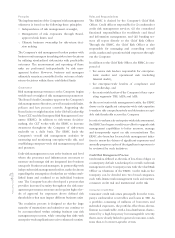American Express 2004 Annual Report Download - page 35
Download and view the complete annual report
Please find page 35 of the 2004 American Express annual report below. You can navigate through the pages in the report by either clicking on the pages listed below, or by using the keyword search tool below to find specific information within the annual report.
Interest expense for 2004 declined 4 percent primarily
due to a 9 percent decrease in charge card interest
expense at TRS, reflecting the benefit of a lower effective
cost of funds partially offset by a higher average card-
member receivable balance. Interest expense declined
16 percent in 2003 including a 22 percent decrease in
charge card interest expense at TRS primarily due to the
benefit of a lower effective cost of funds, partially offset
by a higher average cardmember receivable balance.
Other expenses rose 6 percent to $1.9 billion including
costs related to the Threadneedle acquisition, various
industry regulatory and legal matters at AEFA and costs
incurred at AEB relating to the restructuring charges dis-
cussed earlier. These increases were partially offset by
a $117 million net gain on the fourth quarter 2004 sale
of the equipment leasing product line in TRS’ small busi-
ness financing unit, AEBF. Other expenses of $1.8 billion
increased 12 percent in 2003 primarily due to
acquisition-related expenses, the impact of fewer
deferred acquisition costs (DAC) and expenses related
to legal and industry regulatory matters at AEFA. See the
AEFA Results of Operations section for further discus-
sion of DAC and related adjustments.
The estimated gross benefits realized from reengineering
initiatives during 2004 and 2003 were approximately $1.0
billion in each year, a portion of which flowed through
to earnings while the rest was reinvested into business
areas with high-growth potential.
The effective tax rate was 29 percent for both 2004
and 2003.
Critical Accounting Policies
The Company’s significant accounting policies are
described in Note 1 to the Consolidated Financial State-
ments. The following provides information about
critical accounting policies that are important to the
Consolidated Financial Statements and that involve
estimates requiring significant management assump-
tions and judgments about the effect of matters that are
uncertain. These policies relate to reserves for card-
member losses, Membership Rewards costs, invest-
ment securities valuation, asset securitizations and
deferred acquisition costs.
Reserves for cardmember losses
The Company’s reserves for losses relating to cardmem-
ber loans and receivables represent management’s esti-
mate of the amount necessary to absorb losses inherent
in the Company’s outstanding portfolio of loans and
receivables. Management’s evaluation process requires
certain estimates and judgments. Reserves for these
losses are primarily based upon models that analyze
specific portfolio statistics and also reflect, to a lesser
extent, management’s judgment regarding overall
adequacy. The analytic models take into account several
factors, including average write-off rates for various
stages of receivable aging (i.e., current, 30 days, 60 days,
90 days) over a 24-month period and average bank-
ruptcy and recovery rates. In exercising its judgment to
adjust reserves that are calculated by the analytic model,
management considers the level of coverage of past-due
accounts, as well as external indicators, such as leading
economic indicators, unemployment rate, consumer
confidence index, purchasing manager’s index, bank-
ruptcy filings and the regulatory environment. Manage-
ment believes the impact of each of these indicators can
change from time to time and thus reviews these indi-
cators in concert.
Loans and receivables are written-off when manage-
ment deems amounts to be uncollectible, which is gen-
erally determined by the number of days past due. In
general, bankruptcy and deceased accounts are written-
off upon notification, or when 180 days past due for
lending products and 360 days past due for charge card
products. For all other accounts, write-off policy is based
upon the delinquency and product. Given both the size
and volatility of write-offs, management continually
monitors evolving trends and adjusts its business strat-
egy accordingly. To the extent historical credit experi-
ence is not indicative of future performance or other
assumptions used by management do not prevail, loss
experience could differ significantly, resulting in either
higher or lower future provisions for losses, as appli-
cable. As of December 31, 2004, if average write-off rates
were 5 percent higher or lower, the reserve for losses
would change by approximately $90 million.
Membership Rewards costs
The Company’s Membership Rewards program allows
enrolled cardmembers to earn points that can be
redeemed for a broad range of rewards including
travel, entertainment, retail certificates and merchan-
dise. The Company establishes reserves to cover the
cost of future reward redemptions and typically makes
payments to its reward partners when cardmembers
redeem their points. The reserve for Membership
Rewards is estimated using models that analyze
redemption statistics and also reflect, to a lesser extent,
management’s judgment regarding overall adequacy.
The ultimate points to be redeemed by cardmembers
are estimated based on many factors including past
redemption behavior of cardmembers, product type,
year of enrollment, spend level and duration in the
AXP
AR.04
33
Financial Review
























